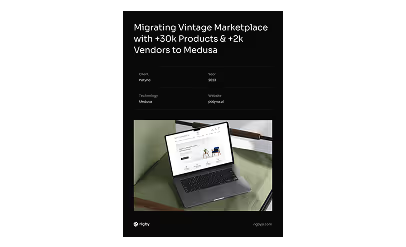SaaS Marketplace Based on Medusa
Developing Minimum Viable Product (MVP), on a custom Medusa solution for SaaS Marketplace offering third-party applications. The project handles multi-vendor transactions, subscription models, usage-based billing, and automated tax calculations.




Client
SaaS Marketplace is a marketplace for selling access to third-party applications, functioning as a platform where vendors can offer their software products and users can seamlessly purchase and access these applications.
Centralized authentication with Keycloak
Subscription management system
Usage-based billing & automated tax calculations
Download case study

Problems

Challenge
SaaS Marketplace approached us with a set of requirements to support their vision of becoming a leading marketplace for third-party applications. The client needed to build a platform capable of handling multiple technical and operational challenges.
Marketplace-Ready Payment System
SaaS Marketplace required a completely new payment system to be built from scratch, designed to support a marketplace model. This meant not only handling customer payments but also managing the flow of funds between multiple sellers and the platform.
Multi-Party Transactions
The solution needed to allow transactions between customers and multiple vendors, with a system that could handle dividing payments and track earnings for each vendor in real-time.
Subscription-Based Models for Sellers
In addition to standard one-time purchases, SaaS Marketplace wanted to offer its vendors the ability to create subscription-based pricing.
Usage-Based Pricing for Flexible Monetization
Flexibility was key, and the platform needed to support usage-based pricing models. Vendors should be able to monetize their software based on how much their customers use it.
Scalability for Growth
With expansion in mind, the system needed to be scalable. SaaS Marketplace envisioned growth on a global scale, so the platform had to handle increasing user demands, transaction volumes, and product listings without sacrificing performance.
Accurate and Automated Tax Calculation System
The global nature of SaaS Marketplace required the integration of a tax system that needed to automatically calculate and apply taxes based on the customer’s location, following international tax rules.

Solutions
To meet SaaS Marketplace's requirements, we implemented a solution integrating Stripe Connect with Medusa's framework. Our approach included:
Custom Medusa Development
We extended Medusa’s capabilities to integrate with Stripe. This allowed for smooth payment processing, and subscription handling.
Stripe Connect Integration
We used Stripe Connect’s APIs to handle payment flows required for multi-vendor transactions. This allowed for efficient management of payments between customers and vendors, including splitting and tracking revenue.
Automated Payout System
We developed a system to automatically manage payouts to vendors. This system accounted for subscriptions, usage-based fees, platform fees, and taxes.
Subscription Management System
We set up Stripe Subscriptions to allow vendors to sell their products with subscription plans. This gave both vendors and customers more flexibility in how they manage and pay for products. Our solution supports diverse pricing models:
Created tiered subscription plans in Stripe
Implemented usage tracking and reporting from Medusa to Stripe
Instead of using Stripe’s built-in automated billing for usage-based pricing, the client wanted full control over the process. So, we replicated Stripe's functionality within Medusa, enabling the client to handle usage tracking and invoicing directly through the platform.
We implemented usage tracking by creating a custom endpoint in our API, where vendors could send data on how much of their product or service (e.g., GBs of data) their customers had used. This allowed vendors to report usage in real-time.
Once a month, our system gathered all this usage information from the vendors. Based on that data, we generated invoices for the customers, calculating their charges for the usage over the month. These invoices were then processed through Stripe.
Developed a flexible pricing engine to combine subscription and usage fees
We developed a flexible pricing engine that allowed vendors to define multiple pricing models for the applications they sold on the platform. This system gave vendors the ability to offer:
1. Fixed one-time payments: Vendors could set a single, upfront price for their application, allowing customers to purchase the app outright.
2. Subscription plans: Vendors could create subscription models with monthly or yearly billing cycles. They also had the option to offer trial periods, letting customers test the product before committing to a full subscription.
3. Subscription + usage-based pricing: This model combined a fixed monthly subscription with usage limits. For example, a vendor could charge $20 per month for their app (e.g., an image generation tool) and include 100 image generations as part of that fee. If a customer exceeded the 100-image limit, additional usage charges would apply. For instance, if the vendor set a rate of $0.50 per additional image, and the customer generated 110 images in a month, the invoice would include the $20 subscription fee plus an extra $5 for the 10 additional images.
It gave vendors more control over how they monetize their products, catering to a variety of customer needs.
Metric-Based Billing
Some of SaaS apps were intended to use AI and therefore required a custom billing approach, which included metered billing. Stripe’s metered billing feature was utilized to allow for usage-based pricing models. This gave vendors the ability to charge customers based on actual usage, offering more adaptable monetization options.
Tax Automation
Stripe Tax was integrated to automate tax calculations, ensuring compliance with international tax regulations. This eliminated the complexity of managing tax rates across different regions.This approach:
- Implemented collection for transactions across different regions.
- Integrated tax reporting capabilities to simplify compliance and reporting processes.
Stripe-Hosted Onboarding
We implemented Stripe’s pre-built, hosted onboarding process for sellers. This approach:
- Simplified compliance with KYC/AML regulations.
- Reduced development time by using Stripe’s secure, pre-designed UI.
- Ensured a consistent and secure onboarding experience.
Data Synchronization and Webhooks
To maintain data consistency between the marketplace and Stripe:
- We created a webhook handling system to manage the high volume and variety of events from Stripe. This system includes event prioritization, retry logic for failed webhook deliveries, and a custom dashboard for monitoring and troubleshooting webhook activities.
- We implemented error handling and retry mechanisms for any failed synchronization events, ensuring data integrity across the platform.
Scalability and Performance Optimization
To ensure the platform could handle high transaction volumes, we implemented database indexing and caching strategies in Medusa, improving performance and scalability.
Product Feedback System and Moderation
We developed a product review system where users could:
- Review each product individually.
- Leave ratings, write reviews, and attach images.
- Participate in threaded discussions and report reviews.
- The section is paginated and can be sorted for reviews of a specific product by rating, date, number of likes, or number of images added.
Additionally, we implemented advanced moderation tools for marketplace admins. An admin can enter any product from the storefront and directly moderate the specific review section. They can:
- Delete reviews
- Ban users from a review section
- Freeze or hide review sections
Vendors can also moderate their product review section and engage with the community. From the vendor panel, they can:
- Reply to user reviews
- Edit or delete their replies
- Report reviews to admins
This system addresses the client's requirements while promoting user interaction and maintaining content quality through moderation measures.


Results



The team was very flexible, changing the scope and the entire management flow in response to our feedback. Rigby's founders were dedicated to the project.

Let’s build together
Let’s talk about how we can build your commerce project — tailored to your business, powered by Rigby

Got a project in mind? Let’s talk

“We build engines for growth, tailored to how your business actually works. Let’s talk about how we can help bring your vision to life.”













